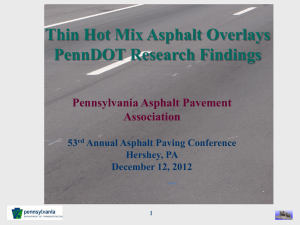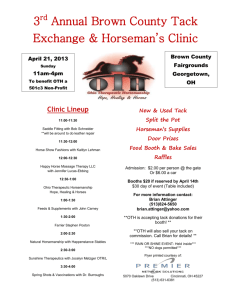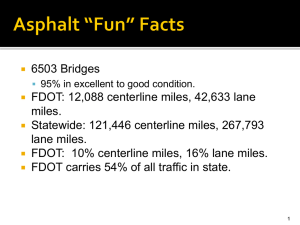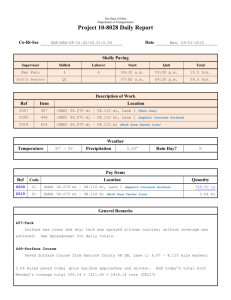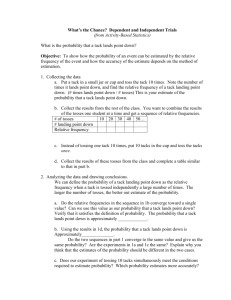407 Tack Coat - Ohio Department of Transportation
advertisement
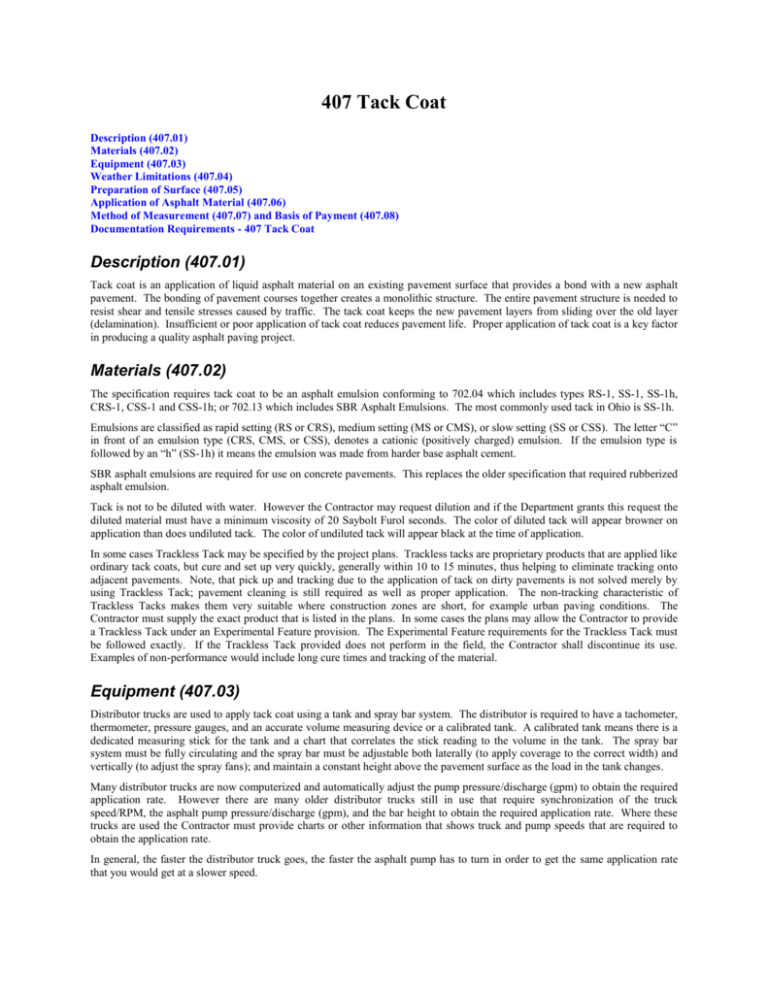
407 Tack Coat Description (407.01) Materials (407.02) Equipment (407.03) Weather Limitations (407.04) Preparation of Surface (407.05) Application of Asphalt Material (407.06) Method of Measurement (407.07) and Basis of Payment (407.08) Documentation Requirements - 407 Tack Coat Description (407.01) Tack coat is an application of liquid asphalt material on an existing pavement surface that provides a bond with a new asphalt pavement. The bonding of pavement courses together creates a monolithic structure. The entire pavement structure is needed to resist shear and tensile stresses caused by traffic. The tack coat keeps the new pavement layers from sliding over the old layer (delamination). Insufficient or poor application of tack coat reduces pavement life. Proper application of tack coat is a key factor in producing a quality asphalt paving project. Materials (407.02) The specification requires tack coat to be an asphalt emulsion conforming to 702.04 which includes types RS-1, SS-1, SS-1h, CRS-1, CSS-1 and CSS-1h; or 702.13 which includes SBR Asphalt Emulsions. The most commonly used tack in Ohio is SS-1h. Emulsions are classified as rapid setting (RS or CRS), medium setting (MS or CMS), or slow setting (SS or CSS). The letter “C” in front of an emulsion type (CRS, CMS, or CSS), denotes a cationic (positively charged) emulsion. If the emulsion type is followed by an “h” (SS-1h) it means the emulsion was made from harder base asphalt cement. SBR asphalt emulsions are required for use on concrete pavements. This replaces the older specification that required rubberized asphalt emulsion. Tack is not to be diluted with water. However the Contractor may request dilution and if the Department grants this request the diluted material must have a minimum viscosity of 20 Saybolt Furol seconds. The color of diluted tack will appear browner on application than does undiluted tack. The color of undiluted tack will appear black at the time of application. In some cases Trackless Tack may be specified by the project plans. Trackless tacks are proprietary products that are applied like ordinary tack coats, but cure and set up very quickly, generally within 10 to 15 minutes, thus helping to eliminate tracking onto adjacent pavements. Note, that pick up and tracking due to the application of tack on dirty pavements is not solved merely by using Trackless Tack; pavement cleaning is still required as well as proper application. The non-tracking characteristic of Trackless Tacks makes them very suitable where construction zones are short, for example urban paving conditions. The Contractor must supply the exact product that is listed in the plans. In some cases the plans may allow the Contractor to provide a Trackless Tack under an Experimental Feature provision. The Experimental Feature requirements for the Trackless Tack must be followed exactly. If the Trackless Tack provided does not perform in the field, the Contractor shall discontinue its use. Examples of non-performance would include long cure times and tracking of the material. Equipment (407.03) Distributor trucks are used to apply tack coat using a tank and spray bar system. The distributor is required to have a tachometer, thermometer, pressure gauges, and an accurate volume measuring device or a calibrated tank. A calibrated tank means there is a dedicated measuring stick for the tank and a chart that correlates the stick reading to the volume in the tank. The spray bar system must be fully circulating and the spray bar must be adjustable both laterally (to apply coverage to the correct width) and vertically (to adjust the spray fans); and maintain a constant height above the pavement surface as the load in the tank changes. Many distributor trucks are now computerized and automatically adjust the pump pressure/discharge (gpm) to obtain the required application rate. However there are many older distributor trucks still in use that require synchronization of the truck speed/RPM, the asphalt pump pressure/discharge (gpm), and the bar height to obtain the required application rate. Where these trucks are used the Contractor must provide charts or other information that shows truck and pump speeds that are required to obtain the application rate. In general, the faster the distributor truck goes, the faster the asphalt pump has to turn in order to get the same application rate that you would get at a slower speed. Example Application Chart for Etnyre Distributor Spray nozzles must be matched to the material and desired application rate. Often the standard nozzles that are installed by the manufacturer are not correct and have to be changed out. If the Contractor cannot get complete coverage at the specified application rate, he may be using the wrong nozzles. All nozzles have to be adjusted to 15° to 30° with the axis of the spray bar in order to get complete coverage. Ensure all nozzles are adjusted to the same angle and are open. Clogged nozzles have to be cleaned or replaced. Misaligned Spray Nozzles The spray bar height must be adjusted to allow spray fan overlap, either single overlap or double overlap if needed for complete coverage. Item 407 does not specify the required overlap and it may not be required to obtain complete coverage when the specified application rate is very light. In some cases with light application rates the Contractor may need to turn off one nozzle per every foot of spray bar and raise the spray bar height to get uniform coverage. Spray Bar Height and Fan Overlap Distributors that cannot apply tack uniformly and at the application rate required shall be removed from the project. Mechanical sweepers, power brooms, street sweepers, and other related equipment may be of any type that will adequately clean the existing surface prior to tack coat application. Weather Limitations (407.04) Apply tack in accordance with the temperature surface requirements for the pavement course being placed. The minimum surface temperatures are provided in 401.06. Record the surface temperature in the Inspector’s Daily Report. Preparation of Surface (407.05) The pavement surface must be dry and free of any foreign material accumulations that interfere with the bond of the tack to the pavement. This includes dust and mud, including dust from milling operations. Excessive use of tack coat should never be a substitute for proper cleaning of pavement. Excessive tack coat can act as lubricant creating a slip plane between pavement layers. Remove all dust, loose aggregate, soil, leaves, and pieces or lumps of other foreign material using power brooms and street sweepers. Blades and hand work may be required for heavy accumulations. Make sure the full width of pavement to be paved is cleaned. Although emulsified tack coat could be applied to a damp pavement; this practice is discouraged should and only be considered in certain critical circumstances where paving cannot be delayed. Damp pavement will require additional cure time and the tack bond may not be as strong. In those cases that paving on a damp surface is allowed by the Engineer there should be no standing or flowing water on the surface of the pavement to be tacked. The time to cure should be closely monitored to ensure the tack application has completely set before paving begins. Application of Asphalt Material (407.06) Protection and Control of Traffic When the contract requires traffic to be maintained, tack coat application should not be allowed to start until the provisions of the traffic maintenance plan have been met. Alternate movement of one-way traffic (flagger operation) must be in place before the distributor is brought into the starting position. Application of Asphalt Material Only asphalt material meeting the requirements of 407.02 can be used. Tack is shipped under ODOT’s Asphalt Materials Certification Requirements as detailed in Supplement 1032. Weight tickets will be provided for the loads of asphalt material delivered to the project. A weigh-back ticket must be provided after the application to accurately determine the quantity of tack used. The weigh-back ticket provides the weight of the material left over and not used. The weight used will have to be converted to gallons based on the appropriate conversion factor for the tack. Although the distributor is required to have an accurate volume measuring device, payment must be made using the weight tickets. Inspect the distributor for compliance with the specifications. The Contractor must demonstrate the use of the required volume measuring device, thermometer, and application controls. Work should not be permitted to start if this equipment is unsatisfactory. In addition, the approval of the distributor is based on observation of the operation and check measurements of the actual application rate, performed as described in the following paragraphs. For large areas, the application rate is determined by the placement of a given quantity of an asphalt material over a known area. The rate is calculated using the gallons (liters) indicated by the volume indicating device on the distributor, the known length of the distributor run, and the measured width that is covered. The rate of application is considered acceptable when the measured application rate is within ±10 percent of the required rate and the tack is uniformly applied. The application rate for small areas, where volume measurement is not practical, may be judged visually. Note that for payment, the quantity used is based on weight tickets not the volume measuring device on the distributor. All of the nozzles should be angled 15º to 30º (depending on the manufacturer) from the axis of the spray bar and the elevation of spray bar should be maintained at a height that produces fully developed fans of bituminous material. The operation of the distributor is judged by visual observation. The quantity of material flowing from each nozzle should be uniform. The angle of each "fan" of material with the spray bar should appear to be at the same angle as specified by the manufacturer. The material should be applied uniformly across the width of the spray bar with no visible streaks and with no apparent variations in the width of spray, from the beginning to the end of the run. The results of the foregoing observations and checks are recorded for each distributor used on the job, together with a means of identification (license plate or equipment number) and indication of approval or non-approval. This information is entered in the project record. The asphalt material should be sprayed uniformly on the pavement surface. The application must be uniform without streaking, thin lines, or dribbles. Streaking is caused by faulty distributor adjustment or operation. Applications with streaking, thin lines, ridges, etc. are not acceptable. The Contractor must be notified to make corrections by adjusting the distributor and the operation to obtain a uniform and consistent application of material across the entire width of the area to be paved. After distributor corrections or repairs, a test strip must be prepared to demonstrate proper application. Do not allow the continued use of equipment that cannot obtain a uniform application. Pick up and tracking of tack by paving equipment and trucks is to be controlled by the Contractor. Pick up occurs due to dirty pavement and, or insufficient cure times. The Contractor is required to take steps to eliminate pick up and tracking. The only way to avoid pick up of a tack coat is to apply the approved material on a clean pavement and allow the material to set up or cure prior to allowing any asphalt delivery trucks or traffic on the tacked lane. This may require the Contractor to lengthen the traffic control zone to allow adequate cure time and perform more thorough pavement cleaning. Pick up and tracking is a serious deficiency and can result in a poor bond. The tracked material ends up on the roadway and can be a safety hazard. When an application is not uniform and not corrected, and, or, there is pick up and tracking, the entire area is considered non specification and will be deducted from payment. Examples of Good Applications Examples of Bad Applications Good Application with Tracking (Left)/Poor Application with Tracking (Right) There may be rare occasions where traffic has to be maintained on a tacked pavement. In such a case the Contractor must place a cover aggregate to maintain a safe construction zone. Cover aggregate is required to be sufficiently dry to permit adhesion of liquid asphalt. When the cover aggregate is placed on an asphalt emulsion tack coat, the aggregate may be moist, but not to the extent that free water drains from the truck bed. The Contractor is required to apply only the quantity of cover aggregate needed to prevent “pick up” of the tack by traffic. A typical rate for applying cover aggregate is 4 to 8 lbs./yd2. Method of Measurement (407.07) and Basis of Payment (407.08) Determine gallons (liters) to be paid from weight tickets and weighed partial loads using Supplement 1060 and ODOT Form CAFP-6. Where tack application is determined to be inadequate and non-specification, determine the number of gallons (liters) for nonpayment by using the approved rate of application times the total square yards (square meters) of non-uniform application. Cover aggregate is included in the bid price for the tack coat. Documentation Requirements - 407 Tack Coat 1. 2. 3. 4. 5. 6. 7. 8. 9. 10. Measure and document surface temperature. Document surface preparation (sweeping, cleaning) and condition of surface just prior to tack application. Document the temperature of material as delivered to the project. Document equipment used and conformance to specifications. Calculate and document rate of application and comparison to required rate. Document the use of any cover aggregate. Document any issues with application (streaks, lines, ridges) and actions taken to correct. Document areas of non-uniform application and payment deductions Calculate and document for pay the number of gallons applied per 407.08, 407.09 and 109.01 Use form CA-FP-6 and other approved forms to document the tack application and calculations.
